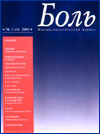Gender and cultural differences of postoperative pain description in an iranian society
Alireza Nikbakht Nasabadi, Vahid Zamanzadeh
Tehran Medical Sciences University, School of Nursing and Midwifery, Tohid sq., Tehran, Iran
Aims of investigations: To explore and comparison of differences in use of descriptors in
a group of Iranian patients.
Methods: 30 male and female patients, between The ages of 12-60 who meet The Criteria (i.e:
farsi language, at least 2 days after surgery...) Participated in this study.
Using qualitative method, including semi structured open-ended interview we explore the meanings and
descnptive languages in narrating of their pain.
noising expression have been observed in female and rural patients with complaints , groaning and rarely crying. Religious values are the most important factor in coping with pain and their expressions of pain, in all patients in Iran. The expression of pain as well as response to pain varies with culture, gender, age, environment and even Individuals.
Conclusions: There were meaningful different in pain descriptions by gender and cultural context. So, a complete socio - cultural assessment of patients with pain is necessary and highly recommended, before nurses decided to planing care for them.
The influence of group cohesiveness on patient outcomes in a pain management programme
Dr. lan Hine, Assistant Medical Director, "Input" Pain Management Unit, Bronllys Hospital, Bronllys, Powys, Wales, UK.
Aims of Investigation: To investigate the relationship between group cohesiveness ("morale",
"esprit de corps") and outcome in patients attending a residential Pain Management Programme
(PMP)
Methods: Pre- and post- course measurements of Pain, Depression and Disability from Twenty-four
groups of patients (n=168) attending the PMP were extracted. The groups showing most and least change
were identified along with an "average" group. Members of the five sample groups (n=34)
were sent a questionnaire, adapted from those used in group psychotherapy research to assess group
cohesiveness. Data analysis was performed using the SPSS computer programme.
(2) Questionnaire Data. 94% of the 34 subjects responded. Replies were subjected to Principal Component Analysis, but no statistically significant correlations could be shown between the factors identified and the subjects' individual responses.
Conclusions: A statistical correlation between group cohesiveness and outcome did not appear, but Questionnaire responses indicated a high degree of group cohesiveness throughout the sample, regardless of outcome. ANOVA of outcome data showed highly significant within-subject change. The findings pose methodological, clinical and conceptual questions relevant to practice and research in group therapy, particularly in chronic pain.
Acknowledgements: No conflicting or financial interest.
Conceptions of withdrawal from dialysis treatment: the viewpoints of some healthcare providers and patients
Jocelyne Saint-Amaud, Louise Bouchard, Carmen Loiselle, Pierre Verrier, Stephane Thales & Delphine Roigt, Faculte des sciences infirmieres, Universite de Montreal, Montreal, Canada, H3C 3J7.
Aim of investigation: To describe and compare the conceptions of patients and healthcare
providers on withdrawal of dialysis treatment.
Methods: In this descriptive study, two questionnaires have been developed to survey ethical
issues related to scarcity of resources in dialysis using a sample of 500 patients and 100 healthcare
providers (nephrologists, nurses, social workers, and dietetists) in fourteen dialysis centres in
Quebec (Canada). We present and analyse here some results obtained through the validation of our questionnaires,
and partial results of our survey.
Results: The validation of the questionnaires was made with 16 patients and 17 healthcare providers.
Seven healthcare providers out of 17 think that withdrawal from dialysis is in accordance with good
care. To the question, "Are the wishes of competent patients to stop dialysis respected by your
team", 14/17 give the answer often to always. In the same survey , the majority of the patients
(9/16) considers withdrawal from treatment a form of suicide or euthanasia. Only one patient considers
withdrawal in accordance with good care. Seven patients out of sixteen have already thought of stopping
dialysis, but none has made such a request.
Conclusions: There is a significative difference in the conceptions of patients and healthcare
providers on withdrawal from dialysis. These conceptions are marked by moral values that might influence
the fact that many patients have thought of stopping dialysis, without having ever made any actual
request. Members of care teams should take into account these results, in order to assure that requests
for withdrawal be expressed and discussed, so that their significance is revealed and so that an appropriate
support for whatever the issue be provided.
Acknowledments: Supported by the Social Sciences and Humanities Research Council of Canada.
Pain in Europe III. EFIC 2000, Nice, France, September 26-29, 2000. Abstracts book, p. 334, 349, 364.






